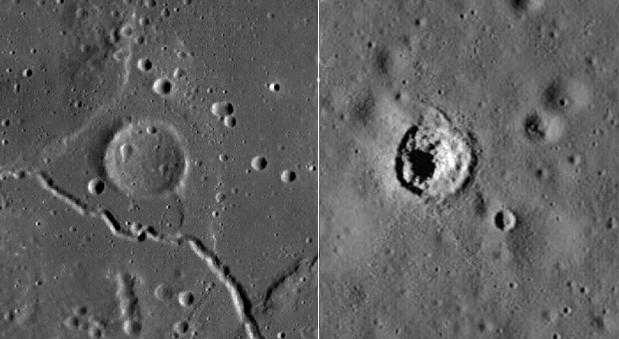Mushies
Contents
- 1 Mushies
- 1.1 Images
- 1.2 Maps
- 1.3 Description
- 1.4 Additional Information
- 1.4.1 The suspected danger of Thomas Gold's moondust
- 1.4.2 Lunar quicksand in Science Fiction and Comics
- 1.4.3 Twelve Apollo astronauts (Apollo 11, 12, 14, 15, 16, 17), none of them was sinking away in a dangerous pool of lunar dust
- 1.4.4 What about those mysterious Irregular Mare Patches (IMPs)?
- 1.4.5 Surface Roughness
- 1.4.6 Catalog of mushy disc shaped "ghost craters", of which their odd surfaces look like... well... elevated custard, porridge, or quark
- 1.4.7 Related pages in the Moon-Wikispaces Project
- 1.5 Nomenclature
- 1.6 LPOD Articles
- 1.7 LROC Articles
- 1.8 Bibliography
Mushies

Photograph at left: the officially unnamed and oddly elevated "ghost crater" southeast of the much larger "ghost crater" Jansen R in Mare Tranquillitatis (nicknamed Jansen R's small companion by D.Caes).
Photograph at right: one of the (perhaps) millions of very small mushies which are scattered all over the moon's surface.
Images
LOTS!!! (take a look at the wealth of Hi-Res NAC images in the LROC ACT-REACT QUICK MAP) (the mosaic of the entire moon's surface).
Maps
The online ACT-REACT QUICK MAP (Lunar Reconnaissance Orbiter).
http://target.lroc.asu.edu/q3/#
Description
In this gradually expanding new experimental page we try to throw some light on not-quite-categorizable lunar surface formations, looking more-or-less like disc shaped blobs of custard, porridge, or quark. The well-known roughness of the "typical" lunar surface (lots of sharp looking craters and craggy mountains, etc..) doesn't really exist. Instead, we try to show you the REAL appearance of the moon's surface (some sort of mushy condition which looks very much as if there is still the danger of being submerged into a semi-fluid substance once you try to walk upon it) (the danger of "lunar quicksand ").
As mentioned above, this is a gradually expanding new experimental page, created by both Danny C. and John M. (very active members of the M.W.P.) (Moon Wikispaces Project).
Mushies is currently an unofficial term.
Additional Information
The suspected danger of Thomas Gold's moondust
About Thomas Gold's odd theory of the dangerous layer of dust on the moon's surface ("lunar quicksand"). See chapter: Thomas Gold's relationship with NASA - in:
Wikipedia page Thomas Gold
Lunar quicksand in Science Fiction and Comics
There are lots of sci-fi stories and comics of astronauts and cosmonauts sinking away in a vast "ocean" of lunar dust, for example Albert Weinberg's adventure of astronauts Dan Cooper and Kid Dereika on their six-wheeled lunar rover (Volume 19, 1973, Apollo calls Soyuz) (the original was known as Apollo appelle Soyouz).
Dan Cooper
It should be mentioned that Canadian astronaut Dan Cooper also discovered a lunar cave full of large brilliant crystal-clusters! Mmmmmm... perhaps... who knows...
Twelve Apollo astronauts (Apollo 11, 12, 14, 15, 16, 17), none of them was sinking away in a dangerous pool of lunar dust
Well, Thomas Gold had original theories, but... his theory of the dangerous lunar quicksand lost credibility once the astronauts of the Apollo program walked on the moon's rather solid surface. BUT... they explored only six landing sites (Apollo 11, 12, 14, 15, 16, and 17). The total number of crash sites and landing sites of every probe and lander (all of them on solid ground) is rather small. Perhaps there are indeed several unknown "oceans of dust", not yet explored by mankind's technology...
What about those mysterious Irregular Mare Patches (IMPs)?
The floor of one of those (rather large) IMPs, officially known as Ina (at or near Lacus Felicitatis), looks very unsteady! It's as if the whole thing never dried out!
NASA (or another spaceflight organisation) should send a simple and rather cheap probe to Ina, to find out if IMPs are made of common lunar regolith (a sturdy solid surface), or perhaps of an equivalent of unsteady custard, wobbly porridge, or shaky quark... or perhaps it's real lunar quicksand...
Surface Roughness
Didn't know that... Seems there's much to read about the roughness of a surface: - https://en.wikipedia.org/wiki/Surface_roughness
Catalog of mushy disc shaped "ghost craters", of which their odd surfaces look like... well... elevated custard, porridge, or quark
- Jansen R's small companion (a nickname from D.Caes for the officially unnamed ghost-crater southeast of the much larger ghost-crater Jansen R), see http://bit.ly/2wtwbzB
- Plinius B. See http://bit.ly/2vpPVkp
- What's beneath Wargentin's elevated surface? I seem to remember a description of the cause of Wargentin's elevated floor. Some scientists (or only one scientist?) thought it was a sheet of disc-shaped ice with a layer of regolith on top of it. Anyway, take a look at the page of Wargentin
Related pages in the Moon-Wikispaces Project
Topsy-Turvy dimple craterlets, looking like small domes
Concentric Craters (CCs)
Irregular Mare Patches (IMPs)
Nomenclature
It would be interesting if the IAU invented an official name for this class of surface formations. For us (the dedicated explorers of the LROC Act-React Quick Map) it feels okay if we continue to use the term Mushies. For the people of the IAU and the USGS, we guess it sounds way too amateuristic.
LPOD Articles
LROC Articles
Bench crater in Plato (post number 446)
Bench crater in Rutherfurd (post number 533)
Impacts on the Melts - ENE of Necho (post number 669)
Bibliography
Thomas Gold is mentioned in the National Geographic of February 1969, page 213 (Moon men).